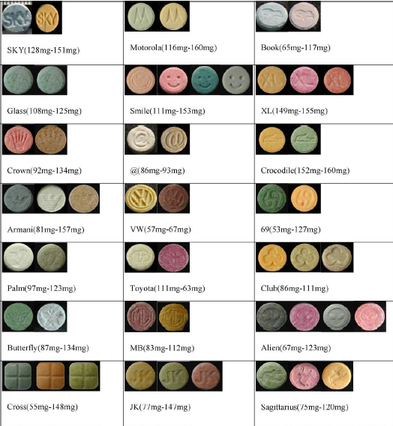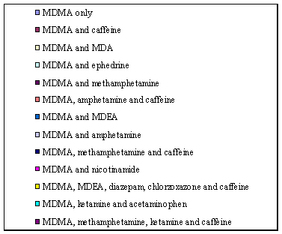STASH Vol. 2(8) – Ecstasy: Is what you see really what you get?
Recreational use of the illegal drug 3,4-methylenedioxymethamphetamine (MDMA), commonly referred to as ecstasy, can result in dangerous consequences. The drug effects have included accelerated heartbeat, jaw clenching, grinding of teeth, nystagmus (i.e., rolling or flickering of the eyes), hallucinations, and death (Kalant, 2001; National Institute on Drug Abuse, 2006; Zervogiannis, 2005).
As Table 1 shows, colors and logos are distinguishing traits of ecstasy tablets. However, because these drugs are trafficked illegally, there is a lack of public knowledge about these identifying features and whether they are indicative of the actual contents of ecstasy tablets. With increased trafficking and seizures of ecstasy tablets in Taiwan during recent years, researchers in Taiwan have been investigating ecstasy use among this population (Cheng, 2003; Ministry of Justice, March 2005). This week’s STASH reviews Teng et al.’s study examining the association between the appearance of ecstasy tablets (i.e., color and logo) and the contents of tablets confiscated in Taiwan (Teng, Wu, Liu, Li, & Chien, 2006).
Figure. Ecstasy Tablets Confiscated in Taiwan Classified by Logo and MDMA Contents (adapted from Teng et al., 2006). Click image to enlarge.
Teng et al. obtained 181 ecstasy tablets for extensive testing by randomly sampling tablets confiscated by the Taiwan National Bureau of Controlled Drugs between January 2002 and February 2005. Researchers analyzed the appearance of the tablets and ground each tablet into powder for component identification and quantification analyses. To determine if tablet appearance has any bearing on content, the authors compared the components and concentration of tablets with the same logo. To ensure the validity of these methods, researchers calculated accuracy in predicting component quantities using the r2 statistic.
Researchers identified 89 distinct color/logo combinations of ecstasy tablets, and the amount of MDMA ranged between 4 and 189 mg/tablet. As Table 1 illustrates, researchers detected MDMA content variation among tablets with the same logos (e.g., 23-100 mg/tablet for tablets with the LV logo). Furthermore, as Figure 1 shows, researchers detected several components other than MDMA in the ecstasy tablets. In all, researchers identified 12 different multi-drug combinations. During 2002 researchers identified two combinations: MDMA with MDA and MDMA with caffeine. In each consecutive year, researchers found more combinations with new components. By 2004, 38% of the confiscated tablets contained MDMA combined with one or more harmful components, including diazepam, a central nervous system depressant that can cause confusion, dysphoria, and fatigue; ketamine, a fast-acting, potentially lethal general anesthetic; and methamphetamine, a nervous system stimulant that increases blood pressure and constricts veins, thereby increasing the risk of stroke and other adverse cardiovascular events; repeated methamphetamine use can cause paranoia, hallucinations, and other psychotic experiences (STASH 2(2); National Institute on Drug Abuse, 2006). Although researches identified only one new combination during 2005, it is important to note that the researchers only sampled tablets during one month of that year; consequently, it is not possible to determine the trend in combinations of confiscated tablets through the end of 2005 from this data. According to results from the statistical analyses, researchers accurately predicted component quantities found in the sample (r2 = 0.997-1)1.
Figure. Yearly percentage of component combinations in a sample of ecstasy tablets confiscated by Taiwan national bureau of controlled drugs between January 2002 and February 2005 (adapted from Teng et al., 2006) * MDA (3,4-methylenedioxyamphetamine); MDMA (3,4-methylenedioxymethamphetamine); MDEA (3,4-methylenedioxymethamphetamine). Click figure to enlarge.
This study has several limitations. First, the apparent increasing number of combinations might be a result of sampling more tablets each consecutive year and not an actual increase in drug combinations. For example, researchers might have underestimated component combinations during earlier study years if some combinations went undetected because of small sample size. Second, the sample likely suffers from selection bias; researchers obtained the study sample from one of the four laboratories in a region of Taiwan, so findings might not be representative of all ecstasy tablets confiscated in that region or of all ecstasy consumed in that region.
Despite these limitations, the findings from this study do illustrate the wide range of illicit drug components found within a sample of confiscated ecstasy tablets. The contents of ecstasy pills, along with the dangers associated with ingesting these additional components cannot be controlled or accurately predicted, because of the illegal and unregulated trafficking of ecstasy. These results suggest additional research is needed to investigate the contents of other illicit drugs to gain a comprehensive understanding of the components that are common within street drugs. For example, understanding the components of street drugs might help medical personnel determine appropriate treatment for individuals with adverse sequelae from these drugs. Given the range of harmful substances found in the ecstasy tablets, public education programs are necessary to inform the general public of the inherent dangers of consuming illegally trafficked substances such as ecstasy.
What do you think? Please use the comment link below to provide feedback on this article.
References
Cheng, W.-C. (2003). Chemical profiling 3,4-methylenedioxymethamphetamine. Forensic Science, 48, 1249-1259.
Kalant, H. (2001). The pharmacology and toxicology of “ecstasy” (MDMA) and related drugs. Canadian Medical Association Journal, 165, 917-928.
Ministry of Justice. (March 2005). Statistics Abstract.
National Institute on Drug Abuse. (2006). MDMA: Ecstasy: National Institutes of Health – US Department of Health and Human Services: US Department of Health and Human Services.
Teng, S.-F., Wu, S.-C., Liu, C., Li, J.-H., & Chien, C.-S. (2006). Characteristics and trends of 3,4methylenedioxymethamphetamine (MDMA) tablets found in Taiwan from 2002 to February 2005. Forensic Science International, 161(2-3), 202-208.
Zervogiannis, F. H., Wiechers, E. & Bester, G. (2005). The “E” in Rave: A profile of young ecstasy (MDMA) users. South African Journal of Psychology, 33(3), 162-169.


